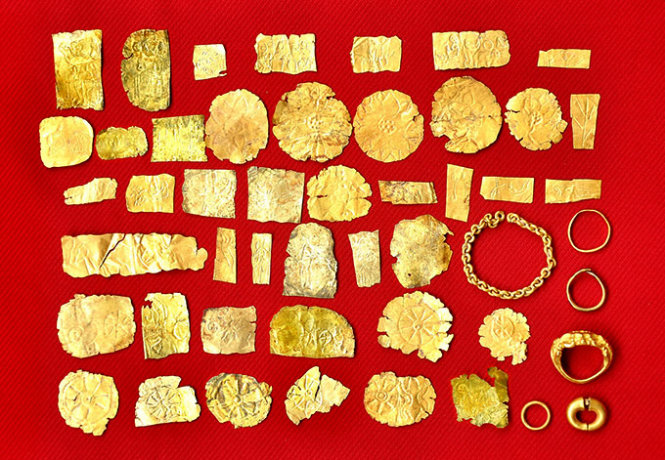An invaluable treasure of antiques, including golden artifacts, has been unearthed during recent excavations in the Dong Thap Muoi area in the Mekong Delta of Vietnam.
>> An audio version of the story is available here
The vast Dong Thap Muoi – covering an area of 631,000 hectares in Long An, Tien Giang, and Dong Thap Provinces – is well known as a flooded plain.
In fact, it has mounds that are about five to seven meters above sea level located in the center of the plain.
The mounds were the residential and worship areas of ancient Vietnamese people about 2,000 years ago.
In 1864-66, the mounds were converted into a military base by Thien Ho Duong to resist against the French invasion.
The real name of Thien Ho Duong is Vo Duy Duong (1827–1866), who was a Vietnamese warlord.
After the submission of the Vietnamese government to the French in 1862, Duong continued to fight against the French (1862-1866) in the wetlands of Dong Thap Muoi.
At that time, with the exception of the soldiers of Thien Ho Duong, the ‘regular inhabitants’ of the area were wild reptiles, mosquitos and leeches.
However, the soldiers were only able to defend themselves for three years and fell to the French in 1866.
French archaeologists then began searching and excavating the area to learn about the ancient civilization in the area, dating back centuries before Christ.
This was the period of the Oc Eo Culture, centered on the southern bank of the Hau River in An Giang Province.
Two French archaeologists, Henri Parmentier and Jean-Yves Claeys, dug up the invaluable treasure, including a stone stele carving in Sanskrit, an ancient language which originated in India.
The stele was built during the Phu Nam Kingdom during the Oc Eo Culture in the area.
The stele was to be transported from Sa Dec in Dong Thap to Saigon, the former name of Ho Chi Minh City, but the ship carrying it wrecked and sank in the Sa Dec River, according to the late Vietnamese researcher Vuong Hong Sen.
Many excavations were attempted by Vietnamese researchers in 1984 and 1993 to find the stele and facts about the history of Dong Thap Muoi, home to numerous antique treasures, according to Doctor Dao Linh Con from the Graduate Academy of Social Sciences in Ho Chi Minh City.
Many golden artefacts were found during the two excavations, mainly in ancient tombs and temples built to worship gods such as Brahma (representing the creator), Vishnu (protector), Shiva (destroyer) and Surya (the Sun).

The statue of God Vishnu was found in Dong Thap Muoi in 1998 and later recognized as a National Treasure. Photo: Tuoi Tre
Ancient Vietnamese people believed that wherever carved figures of gods were buried, the gods existed and appeared there to support people.
Figures of lotuses, animals and objects such as wheels, cookers, lassos, tridents and arrows were also carved on golden plates for burial.
That is why people often carved the figures of gods on gold pieces, which are believed to last forever, and buried them under tombs and temples. The main materials used to build the sites were bricks and sand.
During excavations at a single mound named Go Thap in Dong Thap Muoi, over 300 golden artefacts with simple carvings were dug up, according to Dang Van Thang, professor of the Ho Chi Minh City University of Social Sciences and Humanities and director of the Museum of History and Culture.
Numerous ancient statues were diccovered there, making it a national treasure which helped researchers learn about history and culture and the ancient times of Vietnam.
Samples collected during the excavations at a depth of over two meters were sent to be tested, and the results prove that they date back 2,300-2,400 years ago. This means these objects were created three or four centuries before the birth of Jesus Christ.
Samples of the collection from the fifth to the eighth centuries were sent for an exhibition in New York last year.
The Vietnamese government recognized the statue of Vishnu found in Dong Thap Muoi in 1998 as a National Treasure.
The excavations also proved that Dong Thap Muoi, including Dong Thap, Long An and Tien Giang, was a gulf two thousand years ago.
Over time silt raised the level of the area and turned it into a plain as it is now.
Like us on Facebook or follow us on Twitter to get the latest news about Vietnam!




















































